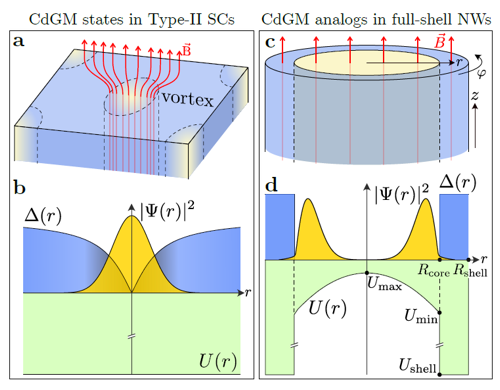Caroli-de Gennes-Matricon analogs in full-shell nanowires
Pablo San-Jose1, Carlos Payá1, C. M. Marcus2, S. Vaitiekenas2, and Elsa Prada1
1 Instituto de Ciencia de Materiales de Madrid, Consejo Superior de Investigaciones Científicas (ICMM-CSIC), Madrid, Spain
2 Center for Quantum Devices, Niels Bohr Institute, University of Copenhagen, 2100 Copenhagen, Denmark
In the search for Majorana bound states in hybrid nanowires, an alternative design with favorable and appealing properties was recently proposed, known as a full-shell nanowire [1]. These new type of hybrid nanostructures consist of a semiconducting core fully surrounded by an epitaxial superconducting shell, which forms a doubly-connected geometry. When subject to an external magnetic flux, these wires exhibit the Little-Parks (LP) phenomenon [2] of fluxmodulated superconductivity, an effect connected to the physics of Abrikosov vortex lines in type-II superconductors [3]. In this seminar I will show [4] that full-shell nanowires can host subgap states that are a variant of the Caroli–de Gennes–Matricon (CdGM) states in vortices. These CdGM analogs are shell-induced Van Hove singularities in propagating core subbands. We elucidate their structure, parameter dependence and behavior in tunneling spectroscopy through a series of models of growing complexity. We find that CdGM analogs exhibit a characteristic skewness towards higher flux values inside non-zero LP lobes, as has been observed in recent experiments. Our analysis provides a transparent interpretation of the nanowire spectrum that allows to extract microscopic information of the encapsulated semiconducting core, which is otherwise inaccessible, by measuring the number and skewness of CdGM analogs with a local tunneling probe [4].

[1] S. Vaitiekenas, G. W. Winkler, B. van Heck, T. Karzig, M.-T. Deng, K. Flensberg, L. I. Glazman, C. Nayak, P. Krogstrup, R. M. Lutchyn, and C. M. Marcus, Science 367 (2020).
[2] W. A. Little and R. D. Parks, Phys. Rev. Lett. 9, 9 (1962). R. D. Parks and W. A. Little, Phys. Rev. 133, A97 (1964).
[3] M. Tinkham, Introduction to superconductivity (Courier Corporation, 2004).
[4] Pablo San-Jose, Carlos Payá, C. M. Marcus, S. Vaitiekėnas, Elsa Prada, preprint arXiv:2207.07606.